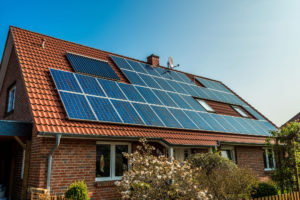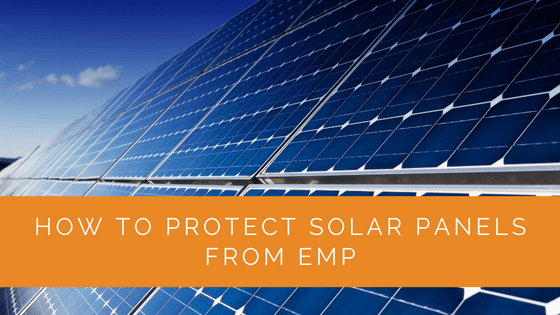Modern infrastructure, ranging from water systems, services, and business to telecommunication, is heavily dependent on satellite-based technology. This ever-growing reliance on technology is highly vulnerable to malfunctioning.
For example, a hiccup in the national power grid would have ripple effects on various economic activities. Everything from water processing, energy supplies, traffic control, logistical systems and even the finance sector won’t be spared from the repercussions of the grid failure.
Satellite-based technologies are known to be vulnerable to the effects of space weather and other electromagnetic activity, such as EMP, which stems from nuclear weapon detonation at high altitudes.
Understanding the gravity of these risks and learning ways to mitigate them has become essential. Such events also affect your day-to-day lives and threaten your solar PV system and other electronic goods.
Although the probability of a nuclear detonation is low, several EMP events like coronal mass ejections occur daily. This threatens the efficiency and lifespan of your PV system.
Walk through this article to learn how to protect your PV panels from EMP.
Contents
- 1 Key Takeaways
- 2 What Is EMP?
- 3 What Is the Probability of An EMP Attack?
- 4 Difference Types of EMP Occurrences
- 5 How Does an EMP Event Affect Your Solar Panels?
- 6 How to Protect Your Solar Panels from EMP?
- 7 Can Solar Panels Be Repaired After an EMP Event?
- 8 Case Study: Mitigating the Impact of EMP on Solar Panels
- 9 Expert Insights From Our Solar Panel Installers About EMP Protection
- 10 Discover the Power of Solar with Solar Panels Network
- 11 Summing Up
Key Takeaways
- Satellite-based technologies and infrastructure are vulnerable to electromagnetic pulses (EMP) caused by space weather, nuclear detonations, or lightning strikes, posing a risk to various systems, including solar panels.
- Protecting solar panels from EMP involves methods such as disconnecting them from the grid during an EMP event, using Faraday cages or bags, implementing EMP-resistant wiring systems, and keeping spare parts on hand to increase the chances of recovery after an EMP incident.
- The impact of an EMP event on solar panels depends on the type and altitude of the EMP. While repair may be possible after an EMP incident, the extent of damage varies and should be assessed by a professional technician.
What Is EMP?
EMP refers to electromagnetic pulse. Electromagnetic pulses are released due to electromagnetic activity or space weather conditions like solar flares, nuclear detonations, and lightning strikes.
EMP creates a “high-density electrical field” that can cause severe destruction of technology on a large geographical scale depending on the altitude of detonation and intensity.
What Is the Probability of An EMP Attack?
Satellite-based technologies are especially at high risk from the impacts of EMP as they can significantly damage the operational devices in space.
The probability of any EMP events occurring due to nuclear weapon detonation at a high altitude is very low. However, the same cannot be said for non-nuclear EMP occurrence.
Extreme space weather can cause geomagnetic storms that severely impact the Earth’s magnetosphere. Although the likelihood of such an event occurring over the coming years is moderate, nothing concrete can be concluded as space weather conditions are highly volatile and dependent on the sun’s behaviour.
Solar activity follows a rough eleven-year cycle, reaching its peak or a “solar maximum” at the end of this loop. It is during this ‘peak’ that space weather becomes extreme. The solar maximum of the eleven-year cycle is expected to occur in July 2025.
Even though solar activity follows a particular time pattern, space weather occurrences don’t. The Carrington Event, which occurred in 1859, is a case in point.
Moreover, there is yet another case to note typical space weather like “Northern Lights” or Aurora Borealis. It might sound surprising, but the “Northern Lights” result from the sun’s charged particles reacting with the Earth’s atmosphere.
Other examples of space weather affecting modern-day infrastructure are coronal mass ejection, solar energetic particles, solar radio bursts, and solar flares.

Difference Types of EMP Occurrences
The effect of EMP depends on the scale and altitude of the cause. Simply put, the impact of a high-altitude EMP (HEMP) differs from a geomagnetically induced or low-altitude nuclear EMP.
A HEMP happens due to the detonation of nuclear ammunition in the Earth’s stratosphere. The gamma rays collide with the Earth’s magnetic field, releasing intense electromagnetic pulses. These magnetic pulses then scatter highly activated electrons, negatively affecting solar panels, sensitive electronics, power lines, etc.
The impact of a HEMP is a thousand times more damaging than a low-altitude nuclear burst. However, the effect of a high-altitude nuclear EMP (HEMP) burst isn’t identical to that of severe space weather.
The EMP created by solar storms creates a string of electromagnetic “waveforms”, each wave having a slightly different impact on the planet. In this case, the cumulative effect will be similar to that of HEMP but less intense and fast than the latter.
How Does an EMP Event Affect Your Solar Panels?
As mentioned earlier, the effect of an EMP occurrence depends on the nature of the cause and the burst’s altitude.
Understanding the separate components of the pulse will help you better grasp the concept. Below is a simplified explanation of the electromagnetic pulse’s E1, E2, and E3 components.
E1
The E1, also known as the “fast” component, occurs after nanoseconds of detonation. It generates a brief yet impactful electromagnetic field amidst this short window, inducing high voltages.
The gamma radiation affects all connected electronic devices so fast that the surge protection of the power grid fails to clamp in time. Although fast clamping surge protectors are also available, they are costly, and often occurring surges are comparatively slower than E1.
E2
The E2 acts like a lightning strike, and the lightning protection absorbs much of the impact if E1 doesn’t damage the circuits. It affects electronic equipment like E1, regardless of whether it is connected to the grid.
E3
E3, unlike E1 and E2, causes extremely high voltages in horizontal electricity transmission like phone lines, power lines, metal pipelines, and railroad tracks. E3 blows off fuses, destroys transformers, and knocks out power plants and substations, burning every sensitive electronic in its wake.
E3 only affects grid-connected electronics.

How to Protect Your Solar Panels from EMP?
EMP poses a grave risk not only to public infrastructure but to your home solar system as well.
Barrier construction per military standards and Faraday cages are a few ways to protect your solar power system against EMP impact. Since EMP travels through electricity transmission lines, investing in an independent solar system will be wise.
Here’s how you can protect your solar power system from EMP.
Disconnect It
EMP travels as waves through the electrical transmission lines. So, if your solar equipment is connected to the grid, unplug it. Disconnecting your system from the grid network will increase its chances of survival during an EMP attack.
However, this method is very effective and wholly dependent on prior announcements and warnings of such attacks. Otherwise, connecting and disconnecting your solar panel continuously in fear of such incidents is inconvenient.
Faraday Cage
Faraday cage is a protective shield immune to electromagnetic waves’ effects. An effective Faraday cage will prevent much of the E1 and E2 impact on your solar panel, thereby having little to no damage to your solar power systems.
Faraday cages are very common and used in various hospitals and restaurants. You can get a Faraday cage in all shapes and sizes and even make one if you don’t find one per your preferences.
Faraday bags are also available if you don’t want to use a bulky cage for EMP attacks with moderate-high chances. These bags are also waterproof and more durable. Additionally, when selecting a Faraday bag, ensure it is puncture-resistant, thick, and has at least 40 dB of strength. Your Faraday bag should have 40dB or more strength to resist a worst-case scenario EMP attack (the Carrington Event)
EMP Resistant Wiring System
An EMP-resistant wiring system is a method of shielding electronic systems against electromagnetic pulses via cables. Cables made of permeable alloy are used for this purpose, and since the military also uses this method, it’s pretty effective.
However, try to keep your wiring system simple. The more complex your wiring system is, the more vulnerable your equipment will be. For instance, a few solar PV panels and car batteries can be well shielded from this method, but the same cannot be said for a complex solar array capable of powering an entire compound.
Try to use different methods to protect your electronics against EMP. This wiring system is inexpensive and thus can be used to safeguard devices like charge controllers, battery banks, and solar inverters.
As for complicated solar stuff, using a Faraday bag will be a much wiser choice.
System Duplicates
Even if you try all the methods mentioned earlier, the probability of your equipment surviving an intense EMP attack is low. Hence, keeping a spare part for each system element handy would be best. Additionally, ensure that all the spare parts are covered and protected in a Faraday bag or cage to deflect maximum magnetic rays.

Can Solar Panels Be Repaired After an EMP Event?
Your solar PV panels can be repaired after an EMP incident if they are not too damaged. To what extent it can be repaired will also depend on the event’s intensity, requiring a thorough inspection. Hence, it would be better to contact your local technician to fully grasp the gravity of the damage if you aren’t an expert on the subject.
Meanwhile, to reduce further damage to your system, you can check for burnt wires or other components and see if you can remove them.
Even if you don’t know how to, it’s okay to communicate this to the technician and ask him for advice. Suppose the condition is not too alarming and can wait for a few moments, great. Suppose it can’t ask your technician to tell you how to remove them.
Case Study: Mitigating the Impact of EMP on Solar Panels
Background
A rural community in the UK, largely reliant on solar energy for electricity, sought to protect its solar infrastructure from potential EMP events. The community’s concern was driven by increasing awareness of the vulnerability of modern technology to electromagnetic disturbances.
Implementation
- Risk Assessment and Planning: The community conducted a thorough risk assessment, considering both nuclear and non-nuclear EMP threats. This assessment included evaluating the local infrastructure’s resilience and identifying critical systems that needed protection.
- Protective Measures: The community implemented several key protective measures:
- Installation of Faraday Cages: Sensitive components like inverters and battery storage systems were housed in custom-built Faraday cages to shield them from EMP effects.
- EMP-Resistant Wiring: Special wiring systems using permeable alloy cables were installed to prevent electromagnetic pulses from damaging the electrical network.
- Disconnection Protocols: A system was established to quickly disconnect the solar panels from the grid in the event of an EMP alert, minimizing potential damage.
- Spare Parts and Backup Systems: Spare inverters, charge controllers, and other critical components were stored in EMP-proof containers for quick replacement if needed.
Results
- Increased Resilience: The measures significantly improved the community’s resilience against potential EMP events. The Faraday cages and EMP-resistant wiring provided robust protection, while the disconnection protocols ensured that the system could be quickly isolated if an EMP threat was detected.
- Cost Savings: By investing in preventive measures, the community avoided potential costs associated with system failure and long-term power outages. The availability of spare parts and backup systems further ensured minimal disruption to power supply.
- Community Awareness and Preparedness: The project also heightened community awareness about EMP risks and preparedness, leading to better overall disaster readiness.
Summary
The case study demonstrates the importance of proactive measures in protecting solar panels and associated infrastructure from EMP threats. The combination of physical protection, strategic planning, and community education can significantly mitigate the risks associated with EMP events, ensuring the continued functionality and reliability of solar energy systems.
Expert Insights From Our Solar Panel Installers About EMP Protection
EMP events, while rare, pose a significant risk to all electronic systems, including solar panels. The key to protecting solar infrastructure lies in strategic planning, including the use of EMP-resistant materials and techniques like Faraday cages, which are crucial for safeguarding the integrity of solar systems during such incidents.
Senior Solar Engineer
While the likelihood of a high-altitude nuclear EMP event is low, solar systems can still be vulnerable to non-nuclear EMPs and severe space weather. Preparing for these events by disconnecting systems during warnings and using protective measures can help mitigate potential damage.
Renewable Energy Specialist
Incorporating EMP-resistant wiring systems and keeping essential spare parts in EMP-proof storage are practical steps for ensuring quick recovery and continuity of solar energy production following an EMP incident.
Energy Systems Consultant
Discover the Power of Solar with Solar Panels Network
Are you navigating the world of solar installations? Look no further than Solar Panels Network, the UK’s trusted partner in harnessing the sun’s potential. Our dedication goes beyond just installations; we’re on a mission to transform how homeowners and businesses across the UK perceive and utilise energy. By choosing us, you’re reducing your carbon footprint and making a smart financial move that promises savings for years ahead. Contact us today and embark on your solar journey.
Summing Up
The EMP protection or mitigation approach is based on quick recovery and pre-emption principles. So, more research is needed in this area to discover better ways of equipment protection and installation capable of withstanding such disasters.
However, till then, you can try these few precautionary methods to minimise the damage to your solar PV panel as much as possible.
About the Author
Solar Panels Network stands at the forefront of solar energy solutions, driven by a team of seasoned solar engineers and energy consultants. With over decades of experience in delivering high-quality solar installations and maintenance, we are committed to promoting sustainable energy through customer-centric, tailored solutions. Our articles reflect this commitment, crafted collaboratively by experts to provide accurate, up-to-date insights into solar technology, ensuring our readers are well-informed and empowered in their solar energy decisions.

